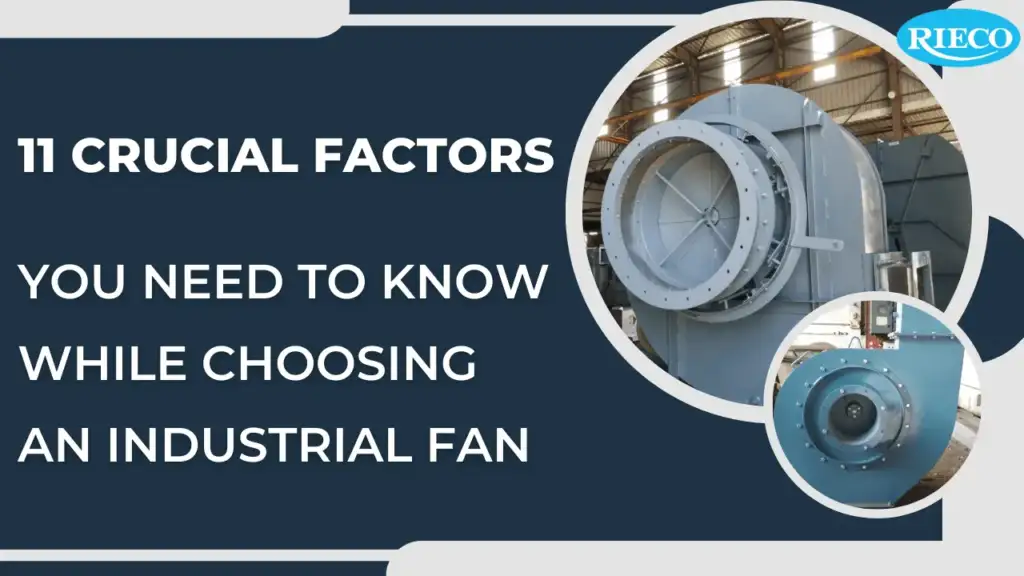All you need to know about Industrial Fans: Crucial Factors while choosing an Industrial Fan (Part2)

Blog
Welcome to the second blog in our series of articles about industrial fans. In this post, we will be discussing the crucial factors that you need to consider when choosing an industrial fan. Industrial fans play a vital role in many manufacturing processes, and selecting the right fan for your facility can make all the difference in terms of efficiency, cost-effectiveness, and employee safety. By understanding these factors, you can make an informed decision when it comes to selecting an industrial fan that will meet your specific needs and requirements. So, let’s dive into the details and learn what you need to know when choosing an industrial fan.
- Airflow requirements: The airflow requirements of the application will dictate the size and type of fan needed. The amount of airflow generated by a fan is a major factor in determining the size and type of fan to select. This airflow can be calculated using the following formula:
Airflow (CFM) = Fan Speed (RPM) x Fan Blade Diameter (in.) x Fan Pitch (in.) x π/6. - Fan static pressure: The system pressure must be taken into consideration when selecting a fan, as this will affect the performance of the fan.The pressure generated by a fan is a major factor in determining the size and type of fan to select. This pressure can be calculated using the following formula:Pressure (in. H2O) = Airflow (CFM) x 0.0362 x Fan Static Efficiency.
- Efficiency: Different types of fans have different levels of efficiency. It is important to select a fan that is capable of meeting the desired airflow requirements while maintaining a high level of efficiency. The efficiency of a fan is a major factor in determining the size and type of fan to select.This efficiency can be calculated using the following formula: Efficiency (%) = (Airflow (CFM) x 0.0362 x Fan Static Efficiency) / (Power (Watts) x 0.746).
- Noise level:
- Fans can produce a considerable amount of noise, so it is important to select a fan that produces minimal noise.
- The noise level of different types of industrial fans can vary significantly depending on the type of fan and its operating conditions. For example, axial fans typically operate at a higher noise level than centrifugal fans due to their higher airflows and speeds.
- Additionally, industrial fans operating in enclosed environments with obstructions may be louder than those operating in open environments.
- Finally, fans operating at higher speeds or larger diameters may be louder than those operating at lower speeds or smaller diameters.
Type of material handled through fan:
- Fibrous material, heavy dust load through fan then chooses radial blade fan.
- Centrifugal fan is used when air is having low to moderate dust content.
Space limitation:
- The size of a fan is also determined by the size of the fan housing, as this affects the amount of air that can be moved by the fan.
- Additionally, the size of the fan may be affected by the type of fan selected, as some fans are designed to be more compact than others.
Operating temperature:
- The temperature requirements will determine the materials and construction of the fan that is needed.
- If the temperature is too high, the fan may not be able to operate properly due to mechanical and electrical stress.
- If the temperature is too low, the fan may not be able to generate enough airflow and will consume high motor powder.
- The fan must also be able to handle the air volume and pressure for the application.
- Additionally, the fan should be designed to be energy efficient and maintain its performance even at higher temperatures.
Direct driven Vs Belt Driven:
- Direct driven exhausters offer more compact assembly and constant speed as they eliminate the losses in belt slippage that occurs in the belt driven fan drives that are not maintained.
- However, flexibility of quick change in fan speed is of definite importance in many applications.
- Increase in fan speed is often required due to changes in the process, hood design, equipment location or clean air equipment.
Corrosive application:Use different MOC and different types of coatings for corrosion resistance.
Method of starting:The motor starter arrangement for industrial fan plays crucial role in fan design as it affects starting time, starting current, and starting transients.
- DOL and star-delta are by far the most commonly employed methods of motor starting.
- However soft starter and VFD are the best methods for starting the fan motor.
- Also, different methods like Hot start and cold start are used based on the location of fan installation and operating temperatures.
Cost:It is important to consider the cost of the fan when making a selection. The cost of the fan will depend on the type and size of the fan, as well as the materials used in its construction.
When it comes to industrial fans, selecting the right one for your facility is paramount to maximizing efficiency, minimizing costs, and ensuring a safe work environment. By carefully weighing these factors and selecting a fan that meets your specific needs and requirements, you can take your manufacturing operations to new heights of productivity and success. To be continued in the next blog of the industrial fan series.
Write to us to know more at rieco@rieco.com.




